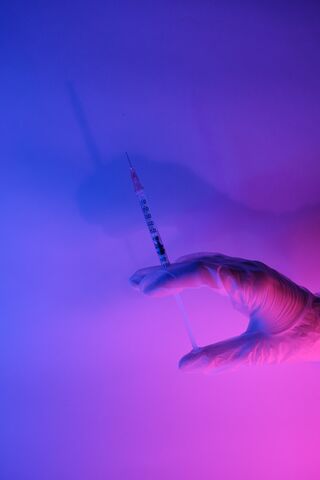Eating disorders (EDs) are some of the most challenging disorders to treat.1 One reason for this is that the causes for ED symptoms are both biological and psychological. These causes include brain chemical imbalances, gastrointestinal issues, stress, low self-esteem, and social exclusion.8

Source: Yerson Retamal/Pixabay
Treating even a single ED symptom (e.g., food restriction), therefore, requires focusing on multiple biological and psychological factors. For example, body dissatisfaction, a common ED symptom, can be caused by both thinness idealization,9 as well as a reduction in certain brain cells.10
Because of these complexities, treatment for EDs requires a team of specialists. These specialists often include medical professionals, therapists, and nutritionists. Each specialist has the job of guiding and monitoring the treatment process from a different perspective. For example, a therapist might work to change someone’s beliefs about their body, while a medical doctor might closely monitor their electrolyte levels during weight gain.
Another hurdle in ED treatment is that while each ED subtype has common symptoms, no two EDs are exactly the same. For example, some individuals with anorexia nervosa (AN) might exercise compulsively, while others don’t. Likewise, different life experiences and genetic makeup mean that some individuals will benefit from certain treatments more than others. And in some cases, individuals with an ED will have additional disorders, such as depression, that will make treatment more complex.
Treatment plans for people with EDs must, therefore, be personalized. This personalization, however, makes it difficult to generalize which treatment approaches are universally effective.
Drug Treatments for Eating Disorders
Despite the numerous professionals involved in ED treatment, however, pharmacological options for treating EDs are often excluded. This is because few drugs have been effective in treating EDs, particularly anorexia nervosa (AN).1

Source: Matteo Badini/Unsplash
In fact, there are currently no drugs approved for treating AN.
This hasn’t stopped some medical professionals from going “off-label” (i.e., using an approved drug to treat something it wasn’t approved for), though, in an attempt to find more effective treatments for AN.
One drug that has been part of these innovative explorations is ketamine.
Ketamine
Ketamine is a drug that was initially used for pain management in the 1960s.2 While it is still used for this purpose, its medical applications have expanded to treat depression, anxiety, and, possibly, AN.
At certain doses, ketamine works in conjunction with the opioid system as an antagonist. To keep us from feeling pain, it prevents certain brain proteins (e.g., NMDA receptors) from doing their job. This is how it can be used for pain-free surgeries.

Source: Alena Shekhovtcova/Pexels
In lower doses, however, ketamine has the opposite effect. Rather than prevent brain cells from communicating with each other, it enhances this communication by increasing glutamate in the brain.3
Glutamate is a body chemical that keeps your brain functioning optimally. This slight ketamine-induced bump in glutamate wakes brain cells up and helps them to communicate more effectively. It also strengthens these communications and creates new ones.
The benefit of using ketamine in treatment over other drugs is that it works faster than antidepressants, with possibly less addiction potential than opioids.
Ketamine and Anorexia Treatment
Because of its successes in treating depression and anxiety, two common disorders associated with AN, doctors are now testing if ketamine might also be effective in treating AN.4
So far, there have been limited case studies testing the effects of ketamine on AN symptoms. Nonetheless, in these studies, ketamine has been shown to reduce AN symptoms (e.g., starvation) and related depression in adults with AN.4 Importantly, there were no significant side effects found during these studies.
How ketamine reduces AN symptoms for some people, however, remains unclear.

Source: Gerd Altmann/Pixabay
One possibility is that ketamine, like antidepressants, alters the serotonin system, which could improve mood and appetite regulation.4 Another possibility is that ketamine helps to fix damaged dopamine pathways in the brain that contribute to AN illness.4 These dopamine repairs could alter an individual’s motivations and what they find rewarding, which could help reduce AN symptoms.
A less specific way ketamine might improve AN symptoms is by enhancing and strengthening brain cell communication. By improving how brain cells talk with one another, ketamine could remedy a variety of brain functions damaged by AN. These effects have the potential to improve how patients with AN manage social situations, learn, and relate to their bodies, all of which contribute to AN illness.4
Animal research has also verified that ketamine has potential for treating AN.6 In one study, it was found that female adolescent mice injected with a single dose of ketamine became resilient to developing AN symptoms.6 These symptoms included voluntary food restriction, excessive exercise, and severe weight loss.6 Consequently, low doses of ketamine during adolescence could protect against AN symptom development.
Future Directions
Currently, human studies testing the effectiveness of ketamine for treating AN have lacked diversity. More research is needed with different age groups, males, and varying levels of symptom severity.

Source: Kindel Media/Pexels
Moreover, we need to further understand how ketamine reduces AN symptoms to determine which individuals are likely to respond best to this treatment. For example, Temizer et al. (2022) discovered that individual differences in ketamine’s effectiveness in AN treatment are partially due to differences in drebrin A, a protein that facilitates brain cell communication.7 Clarifying which individuals are likely to benefit from ketamine treatment protects individuals from enduring ineffective, frustrating, expensive, and uncomfortable treatments. And, for some individuals, their situations are life-threatening and there isn’t time for guesswork.
Also important to consider is that, while ketamine is considered a relatively safe treatment, possible side effects include abdominal pain, kidney and cardiovascular problems, urinary tract issues, and minor nausea and vomiting.4 More research is needed to determine how people with AN, who are often malnourished, respond to ketamine.
Finally, ketamine shouldn’t be considered a single treatment option. Rather, it should be used to enhance treatment. For example, Hermens et al. (2020) suggest that starting AN treatment with ketamine could increase the effectiveness of later treatments, such as zinc supplementation. Zinc is a chemical that is essential for healthy brain processing. People with AN have abnormally low levels zinc and, therefore, increasing zinc is essential for a full recovery. Nonetheless, starting AN treatment with zinc supplementation isn’t very effective, as zinc doesn’t do a good job of jump-starting brain cells if they have been quiet for a long time. Low doses of ketamine, therefore, might be a way for doctors to get the brain up and running in preparation for zinc treatment.5
Treatment teams, therefore, need to consider how ketamine fits into their treatment approach.
To find a therapist, please visit the Psychology Today Therapy Directory.

